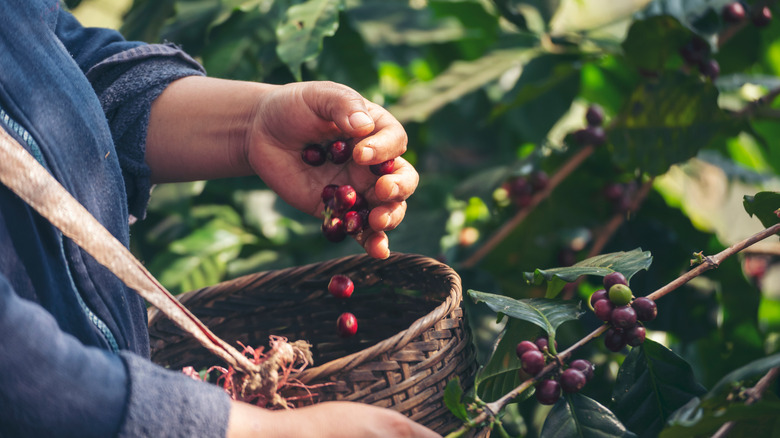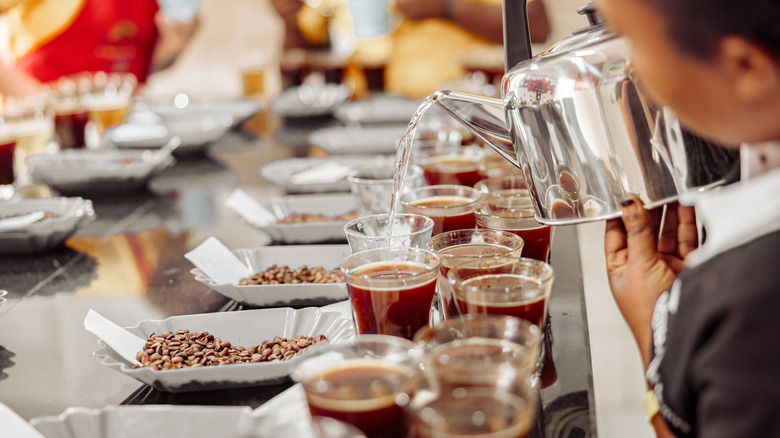What Does It Mean To Roast Coffee 'Nordic Style'?
Between all of the options at third-wave, or specialty coffee shops, it's easy to get tripped up on what's actually on offer. Not only can you choose from Ethiopian and Haitian-sourced beans, but even specific regions within coffee-growing nations. So what does it mean when you see the term "Nordic style" coffee? It has nothing to do with where the coffee beans were grown and harvested, but with the actual level of roasting the coffee beans are put through.
Coffee roasting trends have varied over time, with dark and medium blends dominating coffee shop offerings and grocery store shelves for a very long time. Nordic style roasting, however, focuses on light roasts. Nordic Roasting Co., for example, writes that "craft-roast coffee [brings] out the essence of the different terroirs and [makes] sure that the consumer can appreciate this diversity, enjoy the taste and understand the complexity of coffee," which is achieved through shorter roasting times and lower temperatures.
But when Norwegian-roasted coffees were first brought to coffee distributor cuppings, many rejected the style. However, thanks to an increasing interest in light roasts coffees and premium beans, Nordic style roasts are now more likely to become a favorite of specialty coffee enthusiasts.
Why go light?
Modern coffee roasts are typically categorized between two styles — blends and single origin. Blends use beans from two or more regions, sometimes from multiple countries. The roasting process allows these beans to cook off acidic notes, so a longer roast means more uniform taste between the beans. The result is a darker, richer, more chocolatey and nutty flavor profile. However, with single origin roasts, there is no need to mask flavors, so it doesn't need to undergo a long roast. This produces more acidic flavor notes, like citrus and berries. But Nordic roasters didn't just stop at zeroing in on the region and crop. Beyond country, they looked for "origin, variety, terroir, and processing method," per Vinhood.
In addition to sourcing from multiple areas, coffee was also rarely successfully shipped as "green" in its fruit form. Coffee beans come from coffee cherries, a berry plant, but shipping them from Africa and South America in previous centuries meant the fruit would often spoil somewhat before being roasted. Longer roasting also helped to hide any rotten or funky flavors from the deteriorated fruit. Improved harvesting methods known as natural or dry-processing (via Counter Culture) kept the fruit better intact, and helped farmers and growers to pick out underripe and rotten fruit. This is yet another reason to opt for shorter and lower-temp roasting.
No love at first sip
Thanks to a trade agreement between Brazil and Norway that dates back to the 1800s, per Brewminate, Norwegians were given unprecedented access to coffee at lowered prices. But it wasn't until the 2000s that the Nordic roast was introduced on the world stage as its own unique style. In a conversation with Roest Coffee, Bjørnar Hafslund recalls being introduced to the roasting style by Trish Gothreb. "The roast level she had was so light in comparison to what the industry was used to. Everyone was skeptical. And the fact is, compared to today's standards, it wasn't even so light," he notes. He also believes Norwegians were predisposed to enjoying the more acidic, tangy notes, thanks to diets that rely on tart berries and apples for fresh produce.
While relatively mild by modern tasting preferences, the global coffee industry balked at the thin, acidic roast, wanting more bitter and chocolatey notes that come from darker roasts. But it found a niche in the coffee world. People were actually drawn to a style that highlighted the flavors of the natural coffee cherry and Nordic style roasting may become a standard of specialty shops.


